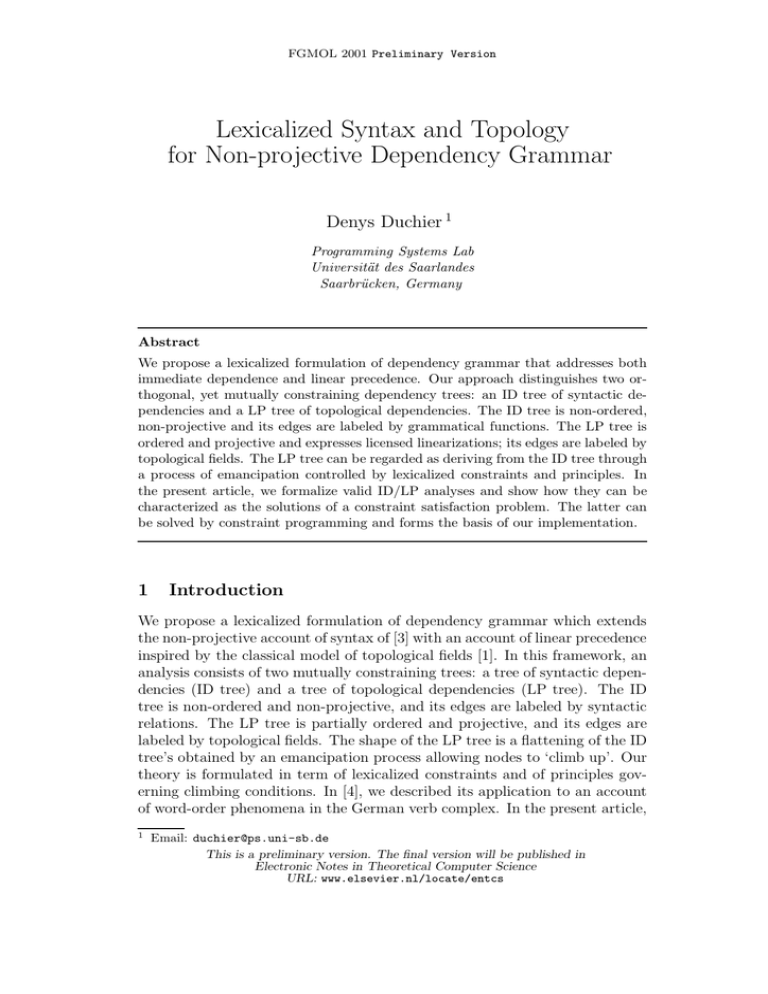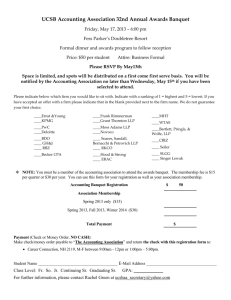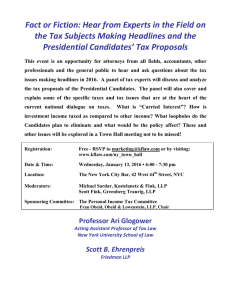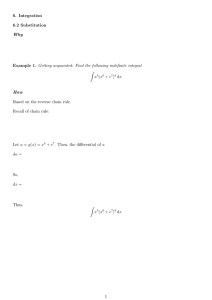Lexicalized Syntax and Topology for Non-projective Dependency Grammar Denys Duchier
advertisement

FGMOL 2001 Preliminary Version
Lexicalized Syntax and Topology
for Non-projective Dependency Grammar
Denys Duchier 1
Programming Systems Lab
Universität des Saarlandes
Saarbrücken, Germany
Abstract
We propose a lexicalized formulation of dependency grammar that addresses both
immediate dependence and linear precedence. Our approach distinguishes two orthogonal, yet mutually constraining dependency trees: an ID tree of syntactic dependencies and a LP tree of topological dependencies. The ID tree is non-ordered,
non-projective and its edges are labeled by grammatical functions. The LP tree is
ordered and projective and expresses licensed linearizations; its edges are labeled by
topological fields. The LP tree can be regarded as deriving from the ID tree through
a process of emancipation controlled by lexicalized constraints and principles. In
the present article, we formalize valid ID/LP analyses and show how they can be
characterized as the solutions of a constraint satisfaction problem. The latter can
be solved by constraint programming and forms the basis of our implementation.
1
Introduction
We propose a lexicalized formulation of dependency grammar which extends
the non-projective account of syntax of [3] with an account of linear precedence
inspired by the classical model of topological fields [1]. In this framework, an
analysis consists of two mutually constraining trees: a tree of syntactic dependencies (ID tree) and a tree of topological dependencies (LP tree). The ID
tree is non-ordered and non-projective, and its edges are labeled by syntactic
relations. The LP tree is partially ordered and projective, and its edges are
labeled by topological fields. The shape of the LP tree is a flattening of the ID
tree’s obtained by an emancipation process allowing nodes to ‘climb up’. Our
theory is formulated in term of lexicalized constraints and of principles governing climbing conditions. In [4], we described its application to an account
of word-order phenomena in the German verb complex. In the present article,
1
Email: duchier@ps.uni-sb.de
This is a preliminary version. The final version will be published in
Electronic Notes in Theoretical Computer Science
URL: www.elsevier.nl/locate/entcs
Duchier
we focus on its formalization and state a formal well-formedness condition
that precisely characterizes the valid analyses. Furthermore, this condition
can also be interpreted as a constraint program and forms the basis of our
implementation.
2
Dependency Trees for Syntax and Topology
Consider the sentence:
(dass) Maria
einen Mann wird lieben können
(that) Marianom a manacc
will love can
The corresponding syntax tree (ID tree) is shown in Figure 1. This tree is
unordered and non-projective. Its edges are labeled by grammatical functions
such as subject or object.
We associate with it a topological tree (LP tree) ordered and projective,
which is formed from the same set of nodes, but different edges. The edges
of the LP tree are labeled by topological fields. One ID tree may give rise to
several LP trees: Figure 2 displays 3 possibilities for the ID tree of Figure 1.
The edge labels of the LP tree are called (external) fields and are totally
ordered: df ≺ mf ≺ vc ≺ xf. This induces a linear precedence among the
daughters of a node. This precedence is partial because daughters with the
same field label may be freely permuted (which is the basis of our account of
scrambling in the Mittelfeld).
In order to fully linearize a LP tree, each node must also be positioned with
respect to its daughters. We achieve this by additionally assigning a label (d,
n, or v) to each node. These are called internal fields; in Figure 2 they are
shown on the vertical dotted lines joining a node to the word it stands for in
the sentence. It is the combined set of internal and external fields which is
totally ordered: df ≺ d ≺ n ≺ mf ≺ vc ≺ xf
For an edge w−−
ℓ→w ′ in the ID tree, we say that w is the head of w ′ . For a
similar edge in the LP tree, we say that w is the host of w ′ or that w ′ lands on
w. The shape of the LP tree is a flattened version of the ID tree’s obtained by
an emancipation process allowing nodes to ‘climb up’ subject to the following
principles:
Principle 1. A node must land on a transitive head, 2 i.e. its host in the LP
tree must be an ancestor in the ID tree.
Principle 2. A node may not climb through a barrier, i.e. none of its ID
ancestors up to (but not including) its host may block its emancipation. We
consider only a simple version, where a node can block a set of syntactic
relations.
Principle 3. A node must land on, or climb higher than its head. The
intuition here is that when a node climbs, it takes its entire subtree along.
2
This is Bröcker’s terminology.
2
Duchier
t
subjec
v i nf
vi n
f
ct
obje
t
de
(dass) Maria einen Mann wird lieben können
Fig. 1. Syntactic Dependency Tree
df
n
vc
mf
vc
mf
n
v
d
v
v
(dass) Maria einen Mann lieben können wird
mf
df
n
mf
xf
vc
v
n
v
v
d
(dass) Maria einen Mann wird lieben können
mf
xf
vc
mf
n
v
df
v
n
v
d
(dass) Maria wird einen Mann lieben können
Fig. 2. Topological Dependency Trees
3
Labeled Trees
In this section we review the formalization of finite labeled trees presented in
[3] and characterize the trees which can be formed from a finite set V of nodes
and a finite set L of edge labels as the solutions of a constraint satisfaction
problem.
We assume given an infinite set of node variables V and a finite set of edge
labels L. We write G(V, L) for the set of finite graphs G = (V, E) formed
from a finite set of nodes V ⊆ V and the set of labeled edges E ⊆ V × V × L.
Note that, since we assume E to be a set, we only consider graphs without
3
Duchier
ΦID (V, L) ≡
V = roots ⊎ ⊎{daughters(w) | w ∈ V }
∧ |roots| = 1
∧ ∀w ∈ V
eqdown(w) = {w} ⊎ down(w)
∧
down(w) = ∪{eqdown(w ′) | w ′ ∈ daughters(w)}
∧
equp(w) = {w} ⊎ up(w)
∧
up(w) = ∪{equp(w ′ ) | w ′ ∈ mothers(w)}
∧ daughters(w) = ⊎{ℓ(w) | ℓ ∈ L}
∧ mothers(w) ⊆ V ∧ |mothers(w)| ≤ 1
∧ ∀w ′ ∈ V w ′ ∈ daughters(w) ≡ w ∈ mothers(w ′ )
Fig. 3. Well-formedness condition of labeled trees
duplicate edges. We write G(V, L) for the graphs in G(V, L) whose node set
is V .
A finite graph G is a tree whenever it satisfies the following conditions: (a)
each node has at most one incoming edge, (b) there is precisely one node (the
root) with no incoming edge, (c) there are no cycles. We write T(V, L) for
the subset of G(V, L) satisfying these conditions and T(V, L) for the trees in
T(V, L) whose node set is V . We are going to formulate a condition ΦID (V, L)
which a finite graph G = (V, E) ∈ G(V, L) must satisfy in order to be in
T(V, L).
We write w−−
ℓ→w ′ for a directed labeled edge (w, w ′ , ℓ) and w−
−
ℓ→G w ′ for
w−−
ℓ→w ′ ∈ E. We define the successor relation →G = ∪{−
−
ℓ→G | ℓ ∈ L} and
+
∗
write →G and →G for its transitive and reflexive transitive closures. Given a
relation R ⊆ V × V , we define functions R, R−1 : V → 2V and the overloading
R : 2V → 2V as follows:
R(x) = {y | (x, y) ∈ R} R−1 (y) = {x | (x, y) ∈ R} R(S) = ∪{R(x) | x ∈ S}
In this manner, the edges of a labeled graph G induce the following functions:
ℓG
daughtersG
mothersG
rootsG
ℓ→G
= −−
= →G
= daughters−1
G
= V \ →G (V )
downG
eqdownG
upG
equpG
= →+
G
= →∗G
= down−1
G
= eqdown−1
G
Given these definitions and the treeness conditions (a), (b) and (c), we formulate, in Figure 3, a condition ΦID (V, L) which a finite graph G=(V, E) ∈
G(V, L) must satisfy to be in T(V, L). This forms a constraint satisfaction
problem (CSP) expressed in terms of variable roots of type 2V and functional
variables down, eqdown, up, equp, mothers, daughters and ℓ (for all ℓ ∈ L) of
type V → 2V . T(V, L) is in bijection with the solutions of ΦID (V, L).
4
Duchier
4
Configuration Lexicon
We now introduce the notion of a configuration lexicon and define the set of
labeled trees which it licenses. A configuration lexicon (Lex, valency, labels) for
T(V, L) consists of a finite set Lex of variables, called lexical entries, and two
functions: valency : Lex → L → 2N , and labels : Lex → 2L .
An attributed tree is a triple (V, E, α) where (V, E) ∈ T(V, L) and α :
V → Lex assigns a lexical entry to each of its nodes. It is well-configured if it
satisfies:
∀w ∈ V, ∀ℓ ∈ L
∀w, w ′ ∈ V, ∀ℓ ∈ L
|ℓ(w)| ∈ valency(α(w))(ℓ)
′
w−−
ℓ→w ∈ E ⇒ ℓ ∈ labels(α(w ))
′
(1)
(2)
valency(α(w))(ℓ) restricts the licensed number of w’s out-going ℓ-edges. Therefore, valency(α(w)) represents a constraint on the edges offered by w. Conversely labels(α(w ′)) is a restriction on the in-coming edges accepted by w ′ .
We write T(V, L, Lex | valency, labels) for the set of well-configured Lexattributed finite trees with L-labeled edges, and ΦLEX (V, L, Lex | valency, labels)
for the conjunction of ΦID (V, L) with (1–2); this is again a CSP with the additional functional variable α.
5
Linear Precedence Trees
We assume given a finite set of edge labels Llp/e , a finite set of node labels
Llp/n , and a total order ≺ on their disjoint union Llp :
Llp = Llp/e ⊎ Llp/n = {ℓ1 , . . . , ℓn }
ℓ1 ≺ ℓ2 ≺ · · · ≺ ℓn
A linear precedence tree G = (V, E, I, <) consists of a labeled tree (V, E) ∈
T(V, Llp/e), an assignment I : V → Llp/n of node labels to nodes, and a
total order < on V . We say that G is well-ordered if it satisfies the following
conditions:
ℓ1→G w1 ∧ w−−
ℓ2→G w2 ∧ ℓ1 ≺ ℓ2
w−−
∗
′
w1 →G w1 ∧ w2 →∗G w2′ ∧ w1 < w2
w−−
ℓ1→G w1 ∧ I(w) = ℓ2 ∧ ℓ1 ≺ ℓ2
ℓ1→G w1 ∧ I(w) = ℓ2 ∧ ℓ2 ≺ ℓ1
w−−
⇒
⇒
⇒
⇒
w1 < w2
w1′ < w2′
w1 < w
w < w1
(3)
(4)
(5)
(6)
We say that S ⊆ V is <-convex in V , and write convex(S, V, <), iff:
∀w1 , w2 ∈ S, ∀w3 ∈ V
w1 < w3 < w2 ⇒ w3 ∈ S
We say that G is projective iff:
∀w ∈ V
convex(eqdown(w), V, <)
5
(7)
Duchier
We are interested in linear precedence trees which are both projective and
well-ordered and write T(V, Llp/e , Llp/n , ≺) for those whose node set is V .
Again, we are going to characterize the elements of T(V, Llp/e, Llp/n , ≺) as
the solutions of a CSP.
G induces the additional functions projℓG : V → 2V for ℓ ∈ Llp :
projℓG = →∗G ◦ −−
ℓ→G
{w} if I(w) = ℓ
projℓG (w) =
∅ otherwise
for ℓ ∈ Llp/e
for ℓ ∈ Llp/n
projℓG (w) for ℓ ∈ Llp/e is the set of nodes in the subtrees rooted at w’s ℓdaughters. The total order < on V can be extended to a partial order on 2V
as follows:
∀S1 , S2 ⊆ V, S1 < S2 ≡ ∀w1 ∈ S1 , ∀w2 ∈ S2 w1 < w2
The well-ordering conditions (3–6) are satisfied iff the following property holds:
∀ℓ1 , ℓ2 ∈ Llp , ∀w ∈ V
ℓ1 ≺ ℓ2 ⇒ projℓG1 (w) < projℓG2 (w)
The projection projℓG (w) at an edge label ℓ ∈ Llp/e satisfies:
projℓG (w) = ∪{eqdownG (w ′) | w ′ ∈ ℓ(w)}
∀w ∈ V, ∀ℓ ∈ Llp/e
(8)
i.e. it is the union of the eqdown-sets of w’s ℓ-daughters. Each node label
ℓ′ ∈ Llp/n induces a function ℓ′ : V → 2V , where ℓ′ (w) is empty except when
ℓ′ is the node label I(w) assigned to w, in which case it is {w}:
{w} = ⊎{ℓ′ (w) | ℓ′ ∈ Llp/n }
w ∈ ℓ′ (w) ≡ I(w) = ℓ′
(9)
(10)
′
Thus the ‘projection’ projℓG (w) at a node label ℓ′ ∈ Llp/n satisfies:
∀w ∈ V, ∀ℓ′ ∈ Llp/n
′
projℓG (w) = ℓ′ (w)
(11)
The well-ordering conditions are succinctly captured by the following equation:
ℓn
≺ · · · ∪proj
≺
eqdown(w) = projℓ1 (w)∪
(w)
(12)
which has the declarative semantics of:
eqdown(w) = projℓ1 (w) ⊎ · · · ⊎ projℓn (w)
projℓ1 (w) < · · · < projℓn (w)
but often allows for stronger inferences. We write ΦLP (V, Llp/e , Llp/n , ≺) for
the conjunction of ΦID (V, Llp/e ) with conditions (7–12). This is again a CSP,
6
Duchier
with the additional predicate variable < and functional variables I and ℓ′
for all ℓ′ ∈ Llp/n . Tlp (V, Llp/e, Llp/n , ≺) is in bijection with the solutions of
ΦLP (V, Llp/e, Llp/n , ≺).
6
Lexicalized Dependency Grammar
A grammar G is given by finite sets of labels Lid , Llp/e , Llp/n , a total order ≺
on Llp/e ⊎ Llp/n , a lexicon Lex and functions:
valencyid : Lex → Lid → 2N
valencylp : Lex → Llp/e → 2N
labelsid : Lex → 2Lid
labelslp/e : Lex → 2Llp/e
labelslp/n : Lex → 2Llp/n
blocks : Lex → 2Lid
(V, Eid , Elp , I, <, α) is a valid ID/LP analysis iff it satisfies the conditions
below as well as the climbing principles formalized in the next section.
(V, Eid , α) ∈ T(V, Lid , Lex | valencyid , labelsid )
(V, Elp , α) ∈ T(V, Llp/e , Lex | valencylp , labelslp/e )
(V, Elp , I, <, α) ∈ T(V, Llp/e , Llp/n , ≺)
∀w ∈ V I(w) ∈ labelslp/n (α(w))
7
Climbing Principles
In this section, we formalizes our ‘climbing principles’ and show that they too
can be expressed in terms of set constraints. Given an ID/LP analysis, we use
subscripts id, resp. lp, to distinguish similar variables in the ID tree, resp.
the LP tree. For example, we write mothersid (w) for w’s mothers in the ID
tree and motherslp (w) for its mothers in the LP tree.
Principle 1: A node must land on a transitive head. I.e., w →lp w ′ ⇒ w →+
id
w ′. Principle 1 is satisfied whenever:
motherslp (w) ⊆ equpid (w)
(13)
Principle 2: a node may not climb through a barrier. We consider in this
article only a very simple notion of barrier: a node may be a barrier to specific
syntactic relations; we say that it blocks them: e.g. a noun blocks det. The
nodes which w must climb through are:
through(w) = upid (w) ∩ ∪{downid (w ′ ) | w ′ ∈ motherslp (w)}
7
(14)
Duchier
Principle 2 is satisfied whenever:
′
′
w ′′−−
ℓ→w ∈ Eid ⇒ ℓ 6∈ ∪{blocks(α(w )) | w ∈ through(w)}
(15)
Principle 3: a node must land on, or climb higher than its head. This is
satisfied whenever:
uplp (w) ⊆ ∪{equplp (w ′) | w ′ ∈ mothersid (w)}
8
(16)
Example Grammar
Our example grammar uses the following sets of labels:
Lid = {root, sbar, s, det, subj, obj, vinf, vpast, vzu}
Llp/e = {df, vf, mf, vc, xf}
Llp/n = {d, n, c, v}
df is the determiner field, vf the Vorfeld, mf the Mittelfeld, vc the verbal
complement field, and xf the extraposition field. d is an internal field for
determiners, n for nouns, c for verb 1st and 2nd (i.e. the complementizer
field), v for verb last. The total order ≺ is:
d ≺ df ≺ n ≺ vf ≺ c ≺ mf ≺ vc ≺ v ≺ xf
Figure 4 contains an example lexicon. For convenience, valencies are described by sets of wildcarded labels. For example, if valency(e) is described by
{ℓ1 , ℓ2 ?, ℓ3 ∗}, this means:
{1}
if ℓ = ℓ1
{0, 1}
if ℓ = ℓ2
valency(e)(ℓ) =
{0, 1, . . . , ∞} if ℓ = ℓ3
{0}
otherwise
Mann accepts ID labels {subj, obj} and offers ID valency {det}: it may be
subject or object and requires a unique determiner. It accepts LP labels
{vf, mf}, i.e. it may land either in the Vorfeld or in the Mittelfeld. It offers a
unique field df, for its determiner. Furthermore it blocks ID labels {det}, thus
preventing emancipation of its determiner.
For verbs, our grammar distinguishes between coherent (field vc) and extraposed position (field xf). While xf is called the extraposition field, it should
not be regarded as uniquely dedicated to the phenomenon of extraposition.
For example, both Oberfeldumstellung and extraposition are explained here
by migration to the xf field. As we previously described in [4], a number of
8
Duchier
phenomena, such as VP extraposition, partial VP extraposition, optional auxiliary flip, V-projection raising, intermediate placement, obligatory auxiliary
flip, double auxiliary flip, obligatory coherence can be modeled as emergent
from the interaction of our lexicalized constraints.
A finite verb may appear as head of a verb 1st/2nd sentence (internal field
c) in which case it typically offers LP valency {vf?, mf∗, vc?, xf}. It may also
appear in a verb last sentence (internal field v) in which case it does not offer
vf. Finite verbs block all emancipations.
An infinitive in coherent position offers at most vc. This forces its nonverbal arguments to climb to find a landing place. Only ‘zu’ infinitives can
be extraposed, in which case they typically offer {mf∗, vc?, xf?} which makes
possible full or partial extrapositions.
Ersatzinfinitivs are here modeled as infinitives which can be extraposed.
We have implemented a parser using the formalization described in this
article and written a slightly larger grammar than presented here. Our experience so far has been very encouraging and confirms the practical effectiveness
of constraint propagation. For example, parsing the sentence “daß Maria einen
Mann wird lieben können” requires no search. Our parser can also function
in a mode where it disregards the linear order of its input and instead generates all possible linearizations. Figure 5 shows an example of this applied
to the same sentence: the window on the left contains the search tree; the 7
lineralizations are enumerated optimally (without failures). The window on
the right displays one analysis: the ID tree is shown above and the LP tree
below.
9
Conclusion
We described a lexicalized formulation of dependency grammar where an analysis consists of two mutually constraining trees: a non-ordered non-projective
tree of syntactic dependencies (ID tree) and an ordered projective tree of topological dependencies (LP tree). Both trees are subject to similar lexicalized
configuration constraints. Additionally the shape of the LP tree is a flattening
of the ID tree’s obtained by allowing nodes to climb up subject to 3 principles.
We precisely formalized the well-formedness conditions characterizing valid
analyses. Furthermore, this formalization can also be regarded as a constraint
program and forms the basis of our implementation in Oz.
References
[1] Bech, G., “Studien über das deutsche Verbum infinitum,” Munksgaard,
Kopenhagen, 1955.
[2] Bröker, N., “Eine Dependenzgrammatik zur Kopplung heterogener Wissensquellen,” Linguistische Arbeiten 405, Max Niemeyer Verlag, Tübingen, 1999.
9
Duchier
word
daß
einen
Mann
Maria
lieben
zu lieben
zu lieben
können
können
hat
hat
wird
wird
haben
versucht
versucht
syntax
labelsid
valencyid
{sbar}
{s}
{det}
{}
{subj, obj} {det}
{subj, obj} {}
{vinf}
{obj}
{vzu}
{obj}
{vzu}
{obj}
{vinf}
{vinf}
{vinf, vpast} {vinf}
{root}
{subj, vpast}
{s}
{subj, vpast}
{root}
{subj, vinf}
{s}
{subj, vinf}
{vinf}
{vpast}
{root}
{subj, vzu}
{sbar}
{subj, vzu}
topology
labelslp/e labelslp/n valencylp
{vf, xf} {c}
{vc}
{df}
{d}
{}
{vf, mf} {n}
{df}
{vf, mf} {n}
{}
{vc}
{v}
{}
{vc}
{v}
{}
{xf}
{v}
{mf∗, xf?}
{vc}
{v}
{vc?}
{xf}
{v}
{mf∗, vc?, xf?}
{vc}
{c}
{vf?, mf∗, vc?, xf?}
{vc}
{v}
{mf∗, vc?, xf?}
{vc}
{c}
{vf?, mf∗, vc?, xf?}
{vc}
{v}
{mf∗, vc?, xf?}
{xf}
{v}
{mf∗, vc?, xf?}
{vc}
{c}
{vf?, mf∗, vc?, xf?}
{vc}
{v}
{mf∗, vc?, xf?}
blocks
{}
{}
{det}
{}
{}
{}
{}
{}
{}
Lid
Lid
Lid
Lid
{}
Lid
Lid
Fig. 4. Example Lexicon
Fig. 5. Searching for all linearizations of “daß Maria einen Mann wird lieben
können” and displaying one specific analysis
[3] Duchier, D., Axiomatizing dependency parsing using set constraints, in: Sixth
Meeting on Mathematics of Language, Orlando, Florida, 1999, pp. 115–126.
[4] Duchier, D. and R. Debusmann, Topological dependency trees: A constraint-based
account of linear precedence, in: 39th Annual Meeting of the Association for
Computational Linguistics (ACL 2001), Toulouse, France, 2001.
[5] Kahane, S., A. Nasr and O. Rambow, Pseudo-projectivity: a polynomially
10
Duchier
parsable non-projective dependency grammar, in: Proceedings of ACL/COLING
’98, Montréal, 1998, pp. 646–52.
[6] Kathol, A., “Linearization-Based German Syntax,” Ph.D. thesis, Ohio State
University (1995).
[7] Müller, S., “Deutsche Syntax deklarativ. Head-Driven Phrase Structure
Grammar für das Deutsche,” Linguistische Arbeiten 394, Max Niemeyer Verlag,
Tübingen, 1999.
[8] Reape, M., Domain union and word order variation in German, in: J. Nerbonne,
K. Netter and C. Pollard, editors, German in Head-Driven Phrase Structure
Grammar, CSLI, Stanford/CA, 1994 pp. 151–197.
[9] Uszkoreit, H., “Word Order and Constituent Structure in German,” CSLI,
Stanford/CA, 1987.
11





